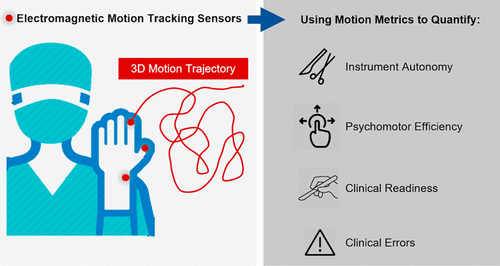当前位置:
X-MOL 学术
›
ACS Biomater. Sci. Eng.
›
论文详情
Our official English website, www.x-mol.net, welcomes your
feedback! (Note: you will need to create a separate account there.)
Sensors and Psychomotor Metrics: A Unique Opportunity to Close the Gap on Surgical Processes and Outcomes
ACS Biomaterials Science & Engineering ( IF 5.4 ) Pub Date : 2020-03-23 , DOI: 10.1021/acsbiomaterials.9b01019 Hossein Mohamadipanah 1 , Kenneth H. Perrone 1 , Katherine Peterson 2 , Jay Nathwani 2 , Felix Huang 3 , Anna Garren 2 , Margaret Garren 2 , Anna Witt 1 , Carla Pugh 1
ACS Biomaterials Science & Engineering ( IF 5.4 ) Pub Date : 2020-03-23 , DOI: 10.1021/acsbiomaterials.9b01019 Hossein Mohamadipanah 1 , Kenneth H. Perrone 1 , Katherine Peterson 2 , Jay Nathwani 2 , Felix Huang 3 , Anna Garren 2 , Margaret Garren 2 , Anna Witt 1 , Carla Pugh 1
Affiliation

|
The surgical process remains elusive to many. This paper presents two independent empirical investigations where psychomotor skill metrics were used to quantify elements of the surgical process in a procedural context during surgical tasks in a simulated environment. The overarching goal of both investigations was to address the following hypothesis: Basic motion metrics can be used to quantify specific aspects of the surgical process including instrument autonomy, psychomotor efficiency, procedural readiness, and clinical errors. Electromagnetic motion tracking sensors were secured to surgical trainees’ (N = 64) hands for both studies, and several motion metrics were investigated as a measure of surgical skill. The first study assessed performance during a bowel repair and laparoscopic ventral hernia (LVH) repair in comparison to a suturing board task. The second study assessed performance in a VR task in comparison to placement of a subclavian central line. The findings of the first study support our subhypothesis that motion metrics have a generalizable application to surgical skill by showing significant correlations in instrument autonomy and psychomotor efficiency during the suturing task and bowel repair (idle time: r = 0.46, p < 0.05; average velocity: r = 0.57, p < 0.05) and the suturing task and LVH repair (jerk magnitude: r = 0.36, p < 0.05; bimanual dexterity: r = 0.35, p < 0.05). In the second study, performance in VR (steering and jerkiness) correlated to clinical errors (r = 0.58, p < 0.05) and insertion time (r = 0.55, p < 0.05) in placement of a subclavian central line. Both gross (dexterity) and fine motor skills (steering) were found to be important as well as efficiency (i.e., idle time, duration, velocity) when seeking to understand the quality of surgical performance. Both studies support our hypotheses that basic motion metrics can be used to quantify specific aspects of the surgical process and that the use of different technologies and metrics are important for comprehensive investigations of surgical skill.
中文翻译:

传感器和心理运动指标:消除手术过程和结果差距的独特机会
手术过程对许多人来说仍然遥不可及。本文介绍了两个独立的实证研究,其中在模拟环境中,在手术过程中使用心理运动技能指标来量化手术过程中要素的过程。两项研究的总体目标是解决以下假设:基本运动指标可用于量化手术过程的特定方面,包括器械自主性,心理运动效率,手术准备情况和临床错误。电磁运动跟踪传感器已固定到外科手术学员的(N两项研究均= 64)只手,并研究了几种运动指标来衡量手术技能。第一项研究评估了肠缝合和腹腔镜腹疝(LVH)修复期间与缝合板任务相比的性能。第二项研究评估了VR任务与锁骨下中心线放置的性能。第一项研究的结果支持了我们的以下假设:运动指标通过在缝合任务和肠修复过程中仪器自主性和心理运动效率上显示出显着相关性,因此可以广泛应用于外科手术技能(空转时间:r = 0.46,p <0.05;平均速度) :r = 0.57,p <0.05)以及缝合任务和LVH修复(急动幅度:r = 0.36,p <0.05;双手灵活性:r = 0.35,p <0.05)。在第二项研究中,VR的表现(转向和颠簸)与临床错误(r = 0.58,p <0.05)和插入时间(r = 0.55,p<0.05)放置锁骨下中心线。当试图了解手术性能的质量时,总的(敏捷)和精细的运动技能(转向)都被认为很重要,同时效率(即空闲时间,持续时间,速度)也很重要。两项研究均支持我们的假设,即基本运动指标可用于量化手术过程的特定方面,并且不同技术和指标的使用对于全面研究手术技能至关重要。
更新日期:2020-03-23
中文翻译:

传感器和心理运动指标:消除手术过程和结果差距的独特机会
手术过程对许多人来说仍然遥不可及。本文介绍了两个独立的实证研究,其中在模拟环境中,在手术过程中使用心理运动技能指标来量化手术过程中要素的过程。两项研究的总体目标是解决以下假设:基本运动指标可用于量化手术过程的特定方面,包括器械自主性,心理运动效率,手术准备情况和临床错误。电磁运动跟踪传感器已固定到外科手术学员的(N两项研究均= 64)只手,并研究了几种运动指标来衡量手术技能。第一项研究评估了肠缝合和腹腔镜腹疝(LVH)修复期间与缝合板任务相比的性能。第二项研究评估了VR任务与锁骨下中心线放置的性能。第一项研究的结果支持了我们的以下假设:运动指标通过在缝合任务和肠修复过程中仪器自主性和心理运动效率上显示出显着相关性,因此可以广泛应用于外科手术技能(空转时间:r = 0.46,p <0.05;平均速度) :r = 0.57,p <0.05)以及缝合任务和LVH修复(急动幅度:r = 0.36,p <0.05;双手灵活性:r = 0.35,p <0.05)。在第二项研究中,VR的表现(转向和颠簸)与临床错误(r = 0.58,p <0.05)和插入时间(r = 0.55,p<0.05)放置锁骨下中心线。当试图了解手术性能的质量时,总的(敏捷)和精细的运动技能(转向)都被认为很重要,同时效率(即空闲时间,持续时间,速度)也很重要。两项研究均支持我们的假设,即基本运动指标可用于量化手术过程的特定方面,并且不同技术和指标的使用对于全面研究手术技能至关重要。











































 京公网安备 11010802027423号
京公网安备 11010802027423号